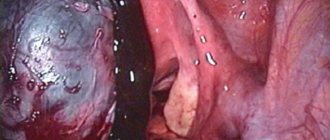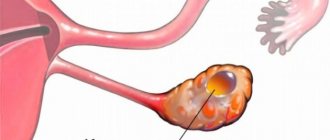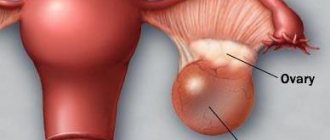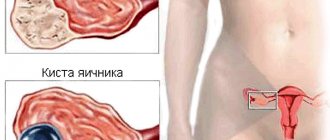- Symptoms
An ovarian cyst is a benign neoplasm filled with fluid, which is most often registered in young women of reproductive age. As a rule, it is discovered accidentally on an ultrasound during examination for another reason. Drug treatment for ovarian cysts can only be prescribed by a doctor. The choice of one drug or another, first of all, depends on the type of neoplasm.
Drug treatment of cysts is not indicated in all cases; its feasibility and scope are determined by the doctor
When using pills for ovarian cysts, you must strictly follow your doctor's instructions. It is important not to complete the full course of treatment and not to change the dosage of prescribed medications. Taking any medications uncontrollably (including numerous advertised dietary supplements with promising names) is not recommended, as this may worsen the condition. When trying to self-medicate, it is easy to miss the time when the tumor can be treated with conservative methods. In addition, it must be borne in mind that a number of cystic formations do not require treatment at all, while others are treated exclusively by surgery.
What is the disease
Ovarian cyst is a common disease of the fair sex. It is a benign formation, the place of formation of which is the gonads. The danger of developing a tumor lies in its asymptomatic course and the frequent development of complications. The most dangerous of them are cancer and infertility.
What causes
There are several reasons for the appearance of cysts. The main one is hormonal imbalance. Among the factors that lead to the occurrence of the disease are:
- development of diabetes mellitus;
- early onset of menstruation, from the age of 9 years, which indicates a clear hormonal imbalance;
- a history of abortions that negatively affect the production of hormones;
- metabolic pathologies;
- pathological changes in the process of follicle maturation;
- various diseases of the female genital organs.
Herbal preparations with hormone-like effects
- Mastodinon . Hormonally active preparation from plant extracts of common twig, cohosh, European cyclamen, Ignatius strychnos, multi-colored iris, tiger lily. Indicated for fibrocystic mastopathy and other hormone-dependent formations in the mammary glands.
- Cyclodinone . Based on an extract from common twig, it contains hormone-like substances that affect hormonal balance. Reduces the content of prolactin, the excess of which leads to cycle disruption and the formation of cystic formations.
Please note that taking hormonal medications should be part of a comprehensive treatment. It is advisable to supplement hormone therapy with light sedatives such as valerian or motherwort, vitamin complexes, tinctures of eleutherococcus or ginseng with a general strengthening effect.
Remember that self-medication with hormones can have irreversible consequences. Only a doctor can prescribe hormonal drugs to treat cysts. This also applies to herbal preparations with hormone-like effects.
The ovaries, which synthesize the necessary hormones, are responsible for the proper functioning of the female reproductive system; they are responsible for the process of pregnancy and many other processes, if disrupted, a complication such as a cyst may appear. Next, we will tell you how you can treat a cyst with medication, without resorting to emergency methods.
Types of education
The direction of therapeutic action is largely determined by the type of tumor. After all, the success of recovery depends on whether the medicine helps or not. Cysts are identified:
- Functional.
They are divided into two subtypes: follicular and luteal. The specificity of their occurrence is that they can regress on their own over some time. The main reason for their development is a violation of the ovulation stage, when the formed follicle degenerates into a cyst, and a change in the process of resorption of the corpus luteum (its location becomes the site of tumor appearance).
- Endometrioid.
The reason for their appearance is the growth of the endometrium in the tissue of the reproductive gland.
- Dermoid.
They are thick-walled formations that are filled with other tissues, such as hair or fat cells. They are characterized by slow and constant growth.
- True cysts (cystadenomas).
They belong to benign formations.
Of these varieties, almost all are treated with surgery. In addition, surgical intervention is mandatory in the presence of complications such as rupture or necrosis.
Comparison of conservative and surgical treatment methods
Advantages of drug treatment compared to surgery:
- maintaining performance during therapy;
- lack of preoperative preparation and rehabilitation period;
- minimal number of side effects;
- ease of use;
- financial inclusion.
Disadvantages of using medications:
- lower efficiency;
- possibility of relapse;
- the likelihood of incorrect selection of treatment;
- slow action of drugs.
Surgical treatment methods are considered a more effective way to remove various formations.
Signs of cyst development
Due to the fact that the disease does not have clear signs, in most cases women skip the initial stage of cyst formation. Typically, a woman receives news of the diagnosis after a scheduled visit to a gynecologist. As a result, lack of treatment causes undesirable consequences.
Symptoms of ovarian cyst formation include:
- the presence of painful appearances during movements, often during intimacy (caused by twisting of the cyst stem or compression of the formation);
- the appearance of a feeling of tension in the abdominal wall;
- with a prolonged course: the appearance of nausea, vomiting, fever, changes in heart rate towards intensification.
Homemade ointment recipes
Hygroma is removed surgically in the absence of positive dynamics of drug therapy. In the initial stages of the disease, folk remedies are highly effective and the availability of components for making ointments.
Home recipes to treat the disease:
- Propolis-based ointment: mix crushed propolis and salted butter in equal proportions. Transfer the mixture into a ceramic bowl and simmer in a water bath for 3 hours. Strain the finished product through cheesecloth into a glass container and store at a temperature of +2ºС-+8ºС. Apply ointment to the hygroma of the knee joint 3 times a day until the formation completely disappears;
- Analgin ointment: crush 10 tablets of the drug to a powder and mix with 200 ml of iodine solution. Use the medicine 2-3 times a day, rubbing the medicine into the hygroma with massage movements until the tumor completely resolves;
- Dissolve 1 tbsp in a glass of boiled water. sea salt. Pour 1 tbsp of the prepared solution. red clay until a paste-like mass is obtained. Apply the mixture to the neoplasm daily until complete recovery;
- Positive feedback on the effectiveness of the following recipe: honey, juice from aloe leaves, Cahors and red wine are mixed under equal conditions until a homogeneous mixture is obtained. Apply the prepared ointment to the hygroma, wrap the limb in polyethylene and a warm cloth, leave overnight, and rinse off the product with warm water in the morning. Use the product until the formation is completely absorbed.
It is necessary to stop treating hygroma with ointments if allergic symptoms appear: itching, rash or redness.
Treatment of hygroma with ointments is a long process. To speed up the healing of the cyst site, it is necessary to combine drugs with physiotherapeutic procedures - warming up and massage of the limb.
Diagnostic procedures
First of all, timely diagnosis is aimed at preventive visits to the gynecologist at least twice a year. If the diagnosis was made earlier, then a visit to the doctor should occur every three months. A test is performed to exclude pregnancy.
An important diagnostic measure for identifying ovarian cysts is ultrasound. Carrying it out allows you to determine the size of the formation and the location of its growth. In addition, the doctor may recommend a tumor marker study and a tomography procedure.
This will eliminate the malignant nature of the formation and determine treatment tactics. Complications of the cyst will require puncture of the posterior vaginal vault. This will help detect the presence of any fluid, including blood, in the abdominal cavity.
Directions of therapeutic influence
Treatment of ovarian cysts is associated with eliminating its root cause – hormonal imbalance. Hormonal drugs are prescribed that have a beneficial effect on the functioning of the appendages. Depending on the specifics of the disease, the doctor prescribes drugs from one of the following groups:
Gestagens
They belong to the sex hormones, of which the main representative is progesterone. These drugs for the treatment of ovarian cysts normalize the performance of the organ’s functions and reduce the likelihood of the formation of formations.
Utrozhestan is most often prescribed. This contraceptive allows you to normalize menstruation and reduce the size of already formed formations. Utrozhestan is also a preventive measure against the degeneration of follicles into cysts. A special place in the group is occupied by drugs - antigonadotropins. They have a suppressive effect on the pituitary gland on the female reproductive glands. These include: Danoval, Danazol.
It should be noted that treatment with hormonal pills is individual in nature. A particular patient is prescribed exactly the medicine that will be most optimal in the treatment process, for example, Yarina or Logest. The use of Norkolut has been shown to be effective in the treatment of ovarian cysts.
The effect of the drug is to increase the secretion of the uterine mucosa, reducing the tone of its muscle layer. In addition, it normalizes the activity of the pituitary gland, disruption of which affects the process of cyst formation. Any pharmacy will offer the prescribed remedy in a different price range.
Oral contraceptives
Their use is based on the effect of drugs on the size of the cyst that has arisen and the process of formation of new tumors. Contraceptive pills belonging to this group and widely used in the treatment of the disease are Janine, Diane-35, Logest.
Regulon is also effective for ovarian cysts, and is therefore often prescribed by a doctor. If you have problems with nails and hair, your doctor may prescribe the use of a product called Qlaira. It should be noted that the choice of drug is determined by the gynecologist based on the woman’s examination data.
Treatment of ovarian cysts with medication: drugs, scheme. Reviews about the effectiveness of treatment
The ovaries, which synthesize the necessary hormones, are responsible for the proper functioning of the female reproductive system; they are responsible for the process of pregnancy and many other processes, if disrupted, a complication such as a cyst may appear. Next, we will tell you how you can treat a cyst with medication, without resorting to emergency methods.
What is a cyst and what types are there?
Every day, millions of processes occur in a woman’s ovaries aimed at producing offspring, namely:
- maturation of follicles for the further appearance of eggs;
– release of a mature egg (so-called ovulation) for its further fertilization;
-synthesis of hormones necessary for the growth and maturation of follicles, as well as in the event of pregnancy, for its successful maintenance;
– regulation of a woman’s menstrual cycle as a whole.
If one of the listed functions stops performing or slows down for some reason, then the woman runs the risk of getting a complication on the ovary such as a cyst.
A cyst is a neoplasm on the surface of an organ, its structure resembles a bubble.
It will be possible to treat ovarian cysts with medication if the following types of cysts are detected:
- Endometrioid cyst.
- Follicular cyst.
- Corpus luteum cyst.
- Polycystic ovary syndrome.
Ovarian cyst. Drug treatment without surgery
Having heard from their attending physician a diagnosis of the presence of a cyst on the ovary, women immediately become despondent. And for some reason it immediately begins to seem that the only way to get rid of it is to perform an operation.
But this is absolutely not true. Many types of ovarian cysts, or rather the most common ones, can be treated with medication. But you shouldn’t expect your doctor to prescribe you a miracle pill that will get rid of such an ailment as an ovarian cyst in one go.
As a rule, the entire treatment regimen is based on hormonal therapy, which means it requires a long time.
Treatment of ovarian cysts with medication can be carried out using procedures such as physiotherapy, magnetic therapy, but only as prescribed by a doctor.
Also, in parallel, medications can be prescribed to reduce pain, anti-inflammatory drugs, and, of course, anti-stress therapy.
The results of such treatment can be judged after 3 months.
However, it should be noted that treatment is prescribed individually for each patient, based on test results, and there is no specific universal scheme that would be suitable for every woman.
Endometrioid cyst
An endometrioid cyst is a type of cyst in which growth of the mucous membrane is observed. It is also commonly called chocolate, since the contents with which it is filled are often dark brown.
As a rule, this cyst occurs on the right, since it has long been established that in women the right ovary works much more actively than the left.
An endometrioid cyst of the right ovary can be treated without surgery. Drug treatment mainly includes therapy aimed at regulating a woman’s hormonal levels:
– hormone therapy: “Diane-35”, “Marvelon”, “Regividon”. It is recommended to take these drugs from the first day of the cycle, strictly at the same time.
– for regulation of the menstrual cycle: “Duphaston”, “Norkolut”.
– drugs for regulating the action of the pituitary gland: “Danol”, “Danazol”.
In parallel to the above medications, immunostimulating drugs such as Cycloferon, vitamins, painkillers and anti-inflammatory drugs are added.
Follicular ovarian cyst. Treatment without surgery
Perhaps this is the most harmless and safest type of cyst that can occur on the ovary. Its appearance is primarily due to the inability of a mature follicle to rupture.
That is, the release of a mature egg into the fallopian tube did not occur. It is at this place that such a new formation then appears. It is recommended to plan pregnancy only after the problem disappears.
Used to treat a disease such as follicular ovarian cyst, treatment without surgery.
The effectiveness of this treatment is almost 95%.
As a rule, the patient is prescribed hormonal drugs, such as Regulon, Mercilon, Diane-35, Marvelon, Regividon or other contraceptive drugs.
Further, painkillers such as “No-shpa”, “Spazgan” may be prescribed. Anti-stress treatment with “Novo-Passit” or “Glycine”, vitamins.
As soon as the patient has her next menstruation, from the second to the fifth day it is necessary to undergo an ultrasound examination in order to confirm the effectiveness of the treatment.
As a rule, a follicular cyst disappears with the first onset of menstruation.
Corpus luteum cyst
This type of cyst forms on the ovary after it has fulfilled its main function - ovulation. In place of the released egg, a corpus luteum is formed, which will secrete the hormone progesterone until the 18th week of pregnancy (if it occurs). However, if the blood flow is disrupted, a cyst may appear in it.
In this case, medical treatment of the ovarian cyst is prescribed. It can be removed with the help of physiotherapy, magnetotherapy, washing the vagina with special solutions, herbs.
Very often, a woman is prescribed a drug such as Duphaston. With the correct dosage, treatment with only one drug will help get rid of the corpus luteum cyst. The woman is also recommended to have sexual rest for the entire period of treatment to avoid twisting of the cyst stem.
In most cases, this cyst resolves on its own, but it requires strict monitoring of its condition by a gynecologist for several cycles.
Polycystic ovary syndrome
This is a type of disease in which the ovaries are significantly enlarged in size. That is, a healthy woman normally matures one egg per month.
Due to the increase in 1 follicle, the ovary swells.
In the case of polycystic disease, several follicles are immediately enlarged in size, but full ovulation does not occur, that is, a large number of cysts of different sizes are present on the ovary at once.
Treatment of cysts with medication is recommended as follows:
– diet therapy: the patient is prescribed a diet to control or reduce weight, and physical activity;
- antihyperglycemic drugs such as Metformin are prescribed.
– hormonal therapy: Diane-35, Marvelon, as well as drugs that suppress the production of male hormones, such as Veroshpiron. This treatment method is used if a woman is not planning a pregnancy.
– When planning a pregnancy, drugs that stimulate ovulation are prescribed, but only under the strict supervision of a doctor, in order to avoid ovarian rupture. Such a drug could be Clomiphene, which must be taken from days 5 to 9 of the cycle for 3-4 months.
As has already become clear from the contents of this article, ovarian cysts can be treated with medication. Reviews about this treatment method are positive from both doctors and patients. Patients say that this treatment method is absolutely painless and safe, despite the rather high cost of the drugs.
Doctors note that drug treatment of ovarian cysts is the most common method of treatment today. It has a lot of advantages, in addition to being absolutely painless: the menstrual cycle is restored and, as a result, problems with skin, hair, and therefore the general mood of the patient as a whole are solved.
The only disadvantage of this treatment is its duration, which can range from 3 to 9 months.
You should not self-medicate and at the slightest suspicion or detection of symptoms, you should seek help from a gynecologist.
Source: https://FB.ru/article/221542/lechenie-kistyi-yaichnika-medikamentoznoe-preparatyi-shema-otzyivyi-ob-effektivnosti-lecheniya











